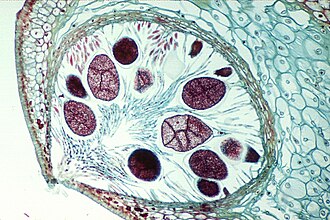Brown algae
A group of mostly marine, multicellular algae
Brown algae (class Phaeophyceae) are a large group of mostly marine, multicellular algae, including many seaweeds located in colder waters within the Northern Hemisphere. They play a significant role in marine environments, both as food and for the habitats they form.
Characteristics[edit]
Brown algae are characterized by their brown or greenish-brown color, which results from the presence of the pigment fucoxanthin, which masks the green of the chlorophyll. They are unique among algae in having this pigment, which is responsible for their distinctive color.

The cell walls of brown algae contain alginic acid, a polysaccharide that is used commercially as a thickening agent in foods and other products. The thallus of brown algae is typically differentiated into a holdfast, stipe, and blade, although these structures can vary greatly in form and function.
Reproduction[edit]
Brown algae exhibit a wide range of reproductive strategies, including both sexual and asexual reproduction. Many species have a complex life cycle involving alternation of generations, with both haploid and diploid stages.

In the sexual reproduction of brown algae, gametes are produced in specialized structures called conceptacles, which are found in some species such as Fucus. The gametes are released into the water, where fertilization occurs.

Ecology[edit]
Brown algae are important components of marine ecosystems. They form dense underwater forests, known as kelp forests, which provide habitat and food for a wide variety of marine organisms. These forests are among the most productive and dynamic ecosystems on Earth.

Economic Importance[edit]
Brown algae are harvested for their alginates, which are used in a variety of industries, including food, pharmaceuticals, and textiles. They are also used as fertilizers and soil conditioners.
Diversity[edit]
The class Phaeophyceae includes a wide variety of species, ranging from small filamentous forms to large kelps. Some well-known genera include Laminaria, Fucus, Sargassum, and Macrocystis.

Related pages[edit]
Ad. Transform your life with W8MD's Budget GLP-1 injections from $75


W8MD offers a medical weight loss program to lose weight in Philadelphia. Our physician-supervised medical weight loss provides:
- Weight loss injections in NYC (generic and brand names):
- Zepbound / Mounjaro, Wegovy / Ozempic, Saxenda
- Most insurances accepted or discounted self-pay rates. We will obtain insurance prior authorizations if needed.
- Generic GLP1 weight loss injections from $75 for the starting dose.
- Also offer prescription weight loss medications including Phentermine, Qsymia, Diethylpropion, Contrave etc.
NYC weight loss doctor appointmentsNYC weight loss doctor appointments
Start your NYC weight loss journey today at our NYC medical weight loss and Philadelphia medical weight loss clinics.
- Call 718-946-5500 to lose weight in NYC or for medical weight loss in Philadelphia 215-676-2334.
- Tags:NYC medical weight loss, Philadelphia lose weight Zepbound NYC, Budget GLP1 weight loss injections, Wegovy Philadelphia, Wegovy NYC, Philadelphia medical weight loss, Brookly weight loss and Wegovy NYC
|
WikiMD's Wellness Encyclopedia |
| Let Food Be Thy Medicine Medicine Thy Food - Hippocrates |
Medical Disclaimer: WikiMD is not a substitute for professional medical advice. The information on WikiMD is provided as an information resource only, may be incorrect, outdated or misleading, and is not to be used or relied on for any diagnostic or treatment purposes. Please consult your health care provider before making any healthcare decisions or for guidance about a specific medical condition. WikiMD expressly disclaims responsibility, and shall have no liability, for any damages, loss, injury, or liability whatsoever suffered as a result of your reliance on the information contained in this site. By visiting this site you agree to the foregoing terms and conditions, which may from time to time be changed or supplemented by WikiMD. If you do not agree to the foregoing terms and conditions, you should not enter or use this site. See full disclaimer.
Credits:Most images are courtesy of Wikimedia commons, and templates, categories Wikipedia, licensed under CC BY SA or similar.
Translate this page: - East Asian
中文,
日本,
한국어,
South Asian
हिन्दी,
தமிழ்,
తెలుగు,
Urdu,
ಕನ್ನಡ,
Southeast Asian
Indonesian,
Vietnamese,
Thai,
မြန်မာဘာသာ,
বাংলা
European
español,
Deutsch,
français,
Greek,
português do Brasil,
polski,
română,
русский,
Nederlands,
norsk,
svenska,
suomi,
Italian
Middle Eastern & African
عربى,
Turkish,
Persian,
Hebrew,
Afrikaans,
isiZulu,
Kiswahili,
Other
Bulgarian,
Hungarian,
Czech,
Swedish,
മലയാളം,
मराठी,
ਪੰਜਾਬੀ,
ગુજરાતી,
Portuguese,
Ukrainian